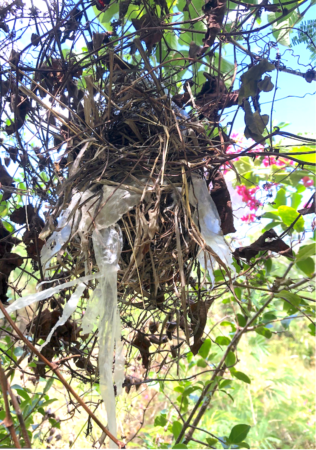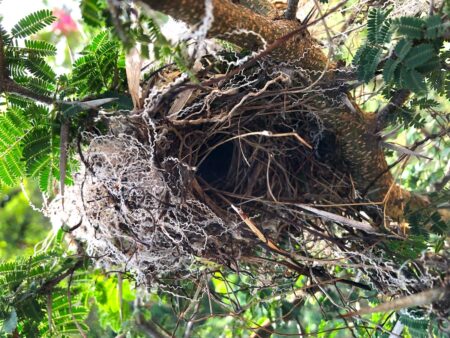BirdsCaribbean is bringing you some highlights from the Journal of Caribbean Ornithology in our new feature “Just Published in JCO.” Here Zoya Buckmire, the Lead Copy Editor for the Journal of Caribbean Ornithology, tells us all about a research note documenting the use of manmade materials by birds to build their nests.

As human influence over the environment increases, so too does the distribution of man-made materials in natural spaces. More and more birds are encountering human debris in their habitat and interacting with these materials in various, often life-threatening, ways, such as mistaking them for food or becoming entangled in them. In this research note, Hannah Madden and Hailley Danielson-Owczynsky document landbirds in St. Eustatius using human debris in an interesting but potentially dangerous way. Their observations shows how pervasive our impact is on the world around us.
But how did this study come about? Our authors found the first nest almost by accident. As they were doing some yard work at Hannah’s property, the two came across a Black-faced Grassquit nest with plastic woven through it. Though they didn’t think much of it at first, a few days later they regrouped and decided to intentionally search the surrounding areas for more nests to see how common the phenomenon was.
They found a total of 19 nests, two which contained man-made debris, including linen, cotton, and polyester fibers and twine and pieces of white and clear plastic bags.
The second nest (shown in the photo below), belonging to a Bananaquit, wasn’t even found by the authors! Hannah’s daughter Lalia takes the credit for that, as she tagged along to the field visit. “She has a very sharp eye,” commented Hannah. “She helped us find the second nest, located along a fairly busy road, that I had overlooked entirely.”

The biggest challenge to this research was the vegetation—acacia and other thorny plants provided many a hazard in the field. The authors were also discouraged by the “depressing amount of garbage in the vicinity, which of course, only makes this study that much more important.
The authors noted that the light-colored man-made materials may increase their visibility to predators leading to higher predation rates, but this needs further study. Their hopes are that their work “will encourage more people in the Caribbean to look out for man-made materials in landbird nests and conduct their own simple study,” said Hannah. “There is so little published literature about this phenomenon, yet it is likely a pervasive issue in the region.” Indeed, plastic pollution is severe throughout the Caribbean. Only through studying its many impacts on bird populations can we begin to understand – and address – this issue.
To learn more, download the research note here: Madden, H. and D. Danielson-Owczynsky 2023. Incorporation of anthropogenic materials into passerine nests on St Eustatius, Caribbean Netherlands. Journal of Caribbean Ornithology 36:26-29. Or use this link https://doi.org/10.55431/jco.2023.36.26-29
More Featured Articles From “Just Published in the JCO
The Journal of Caribbean Ornithology is a peer-reviewed journal covering all aspects of ornithology within the Caribbean region. We welcome manuscripts covering the biology, ecology, behavior, life history, and conservation of Caribbean birds and their habitats. This journal provides immediate open access to its content on the principle that making research freely available to the public supports a greater global exchange of knowledge.
